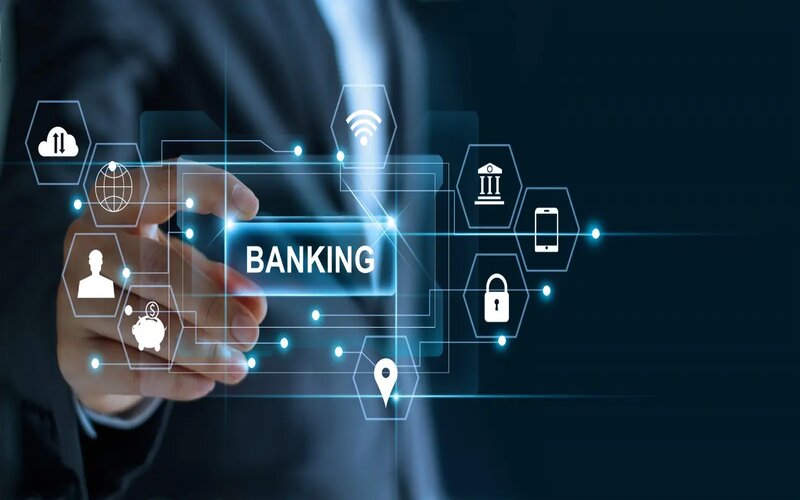Retail, Mobile, Online, and Digital-Only Banking Technologies


As we move deeper into the digital age, the landscape of banking is undergoing a profound transformation.
Digitalization is changing how people interact and conduct business on a day-to-day basis, and advancements in banking technology continue to shape the future of financial services worldwide. The increasing demand for a digital banking experience from millennials and Gen Zers is transforming the entire banking industry.
From retail and mobile banking to neobank startups, technology plays a role in nearly every aspect of the banking industry, and its influence will continue to propel banking into a digitized future.
The traditional model of retail banking is being redefined by advancements in technology, shifting customer preferences, and the rise of digital-only banks. Mobile and online banking, once considered innovative, have now become the standard. The future of banking technology will be shaped by these evolving trends, pushing the industry toward a more digital, seamless, and customer-centric approach. This article explores the future of retail, mobile, online, and digital-only banking technology, examining the innovations and challenges that will define the next era of banking.
The Evolution of Retail Banking

Retail banking has traditionally been characterized by brick-and-mortar branches where customers engage in face-to-face transactions. However, the rapid advancement of technology and the rise of digital communication channels are reshaping this model. Today, retail banks are increasingly focusing on enhancing the digital experience, providing services that can be accessed anytime and anywhere.
1. Branch Transformation
The role of the physical bank branch is changing. While branches are not disappearing entirely, they are evolving to serve a different purpose. Banks are reimagining branches as experience centers, where customers can receive personalized advice, interact with advanced self-service kiosks, and explore new financial products through digital interfaces.
In the future, we will likely see a decline in the number of traditional branches, with banks investing more in flagship branches equipped with cutting-edge technology, such as augmented reality (AR) and virtual reality (VR) to enhance the customer experience. These branches will focus on providing high-value services, leaving routine transactions to digital channels.
2. Personalized Banking
One of the most significant shifts in retail banking is the move towards personalization. Banks are leveraging big data, artificial intelligence (AI), and machine learning (ML) to analyze customer behavior, preferences, and financial needs. This enables them to offer highly personalized products and services.
In the future, retail banking will increasingly adopt predictive analytics to anticipate customer needs before they arise. For example, banks may use AI to predict when a customer is likely to need a loan based on their spending patterns or financial goals. This level of personalization will not only improve customer satisfaction but also drive loyalty and retention.
The Rise of Mobile Banking

Mobile banking has become an essential part of the modern banking experience. With smartphones becoming ubiquitous, customers now expect to manage their finances from their mobile devices. This trend will only intensify in the future, with mobile banking apps becoming even more sophisticated and integral to daily life.
1. Seamless User Experience
The future of mobile banking will be defined by an emphasis on seamless user experiences. Banks will focus on creating intuitive and user-friendly mobile apps that offer a wide range of services, from account management to investment advice. The integration of voice assistants, biometric authentication, and AI-driven chatbots will further enhance the user experience, making mobile banking more accessible and secure.
2. Financial Inclusion
Mobile banking has the potential to drive financial inclusion, particularly in emerging markets where access to traditional banking services is limited. As smartphone penetration increases, more people will gain access to banking services, enabling them to save, invest, and manage their finances more effectively.
In the future, we can expect mobile banking to play a critical role in providing financial services to underserved populations. Banks will develop mobile apps tailored to the needs of these communities, offering microloans, savings accounts, and financial education tools that are accessible via mobile devices.
3. Enhanced Security
As mobile banking becomes more prevalent, security will be a top priority. Cybersecurity threats are constantly evolving, and banks will need to stay ahead of these threats to protect customer data. The future of mobile banking will see the adoption of advanced security measures, such as biometric authentication, blockchain technology, and AI-driven fraud detection.
Biometric authentication, including fingerprint scanning, facial recognition, and voice recognition, will become standard features in mobile banking apps. Additionally, blockchain technology will be used to secure transactions and prevent fraud, while AI-driven algorithms will monitor transactions in real time to detect and prevent suspicious activity.
The Expansion of Online Banking

Online banking has been around for decades, but it continues to evolve and expand. The future of online banking will be characterized by greater integration with other digital services, more sophisticated financial tools, and a focus on customer empowerment.
1. Integration with Digital Ecosystems
Online banking will increasingly be integrated into broader digital ecosystems. Customers will be able to manage their finances alongside other aspects of their digital lives, such as shopping, social media, and smart home devices. For example, online banking platforms may integrate with e-commerce sites to offer seamless payment options or provide real-time financial insights while shopping.
In the future, banks will collaborate with tech companies to create integrated platforms that offer a holistic view of customers’ financial lives. These platforms will enable customers to manage their finances, investments, and even taxes from a single online dashboard, making financial management more convenient and efficient.
2. Advanced Financial Tools
The future of online banking will see the development of more advanced financial tools that empower customers to take control of their finances. These tools will include personalized budgeting software, AI-driven investment advice, and automated savings plans. Banks will offer these tools through their online platforms, helping customers achieve their financial goals with greater ease.
For instance, AI-powered robo-advisors will provide personalized investment advice based on a customer’s financial goals and risk tolerance. Automated savings plans will analyze spending patterns and automatically transfer funds to savings accounts, helping customers save more effectively. These tools will be designed to simplify financial management and make it more accessible to the average consumer.
3. Empowering Customers
Empowering customers will be a central theme in the future of online banking. Banks will focus on providing customers with the information and tools they need to make informed financial decisions. This will include offering educational resources, financial planning tools, and personalized advice.
In the future, online banking platforms will feature interactive financial education modules that teach customers about budgeting, investing, and retirement planning. Banks will also offer personalized financial planning services, where customers can receive advice tailored to their unique financial situations. By empowering customers with knowledge and tools, banks will foster stronger relationships and build trust.
The Emergence of Digital-Only Banks

Digital-only banks, also known as neobanks, are banks that operate entirely online without any physical branches. These banks are challenging traditional banks by offering innovative services, lower fees, and a more customer-centric approach. The future of banking will likely see a significant increase in the number and influence of digital-only banks.
1. The Appeal of Neobanks
Neobanks are appealing to a new generation of customers who value convenience, transparency, and low costs. These banks offer a streamlined experience, often with no hidden fees, faster transactions, and innovative features such as real-time spending notifications and budgeting tools.
In the future, neobanks will continue to grow in popularity, particularly among younger customers who are comfortable with managing their finances entirely online. These banks will also expand their services, offering products such as loans, mortgages, and investment options to compete more directly with traditional banks.
2. Disrupting the Banking Industry
Digital-only banks are poised to disrupt the traditional banking industry by offering a customer experience that is more in line with modern expectations. These banks are agile, able to quickly adapt to new technologies and customer demands. As a result, they can offer innovative services that traditional banks may struggle to provide.
In the future, we can expect neobanks to lead the way in adopting new technologies such as AI, blockchain, and open banking. They will continue to challenge traditional banks by offering more personalized services, lower fees, and greater transparency. This competition will drive innovation across the entire banking industry.
3. Regulatory Challenges
However, the rise of digital-only banks also presents regulatory challenges. As these banks operate entirely online, regulators will need to adapt to ensure that they meet the same standards as traditional banks in terms of security, customer protection, and financial stability.
In the future, we can expect to see the development of new regulatory frameworks designed specifically for digital-only banks. These frameworks will need to address issues such as cybersecurity, data privacy, and the risks associated with rapid growth. As regulators work to keep pace with the changing landscape, digital-only banks will need to balance innovation with compliance.
The Role of AI and Machine Learning

AI and machine learning will play a pivotal role in the future of banking technology. These technologies have the potential to revolutionize every aspect of banking, from customer service to fraud detection to investment management.
1. AI-Driven Customer Service
AI will transform customer service in banking by enabling more personalized and efficient interactions. AI-powered chatbots and virtual assistants will become standard features in mobile and online banking platforms, providing customers with instant assistance and personalized advice.
In the future, AI-driven customer service will be able to handle increasingly complex tasks, such as helping customers apply for loans, managing investments, or resolving disputes. These AI systems will learn from each interaction, continuously improving their ability to serve customers effectively.
2. Predictive Analytics
Predictive analytics, powered by AI and machine learning, will enable banks to anticipate customer needs and offer proactive solutions. For example, banks may use predictive analytics to identify customers who are at risk of defaulting on loans and offer them tailored financial advice or restructuring options.
In the future, predictive analytics will be used to personalize every aspect of the banking experience, from product recommendations to investment advice. Banks will be able to offer highly targeted services that meet the specific needs of each customer, driving customer satisfaction and loyalty.
3. Fraud Detection and Prevention
AI and machine learning will also enhance fraud detection and prevention in banking. These technologies can analyze vast amounts of data in real-time, identifying patterns and anomalies that may indicate fraudulent activity.
In the future, AI-driven fraud detection systems will become more sophisticated, capable of detecting even the most subtle forms of fraud. These systems will be integrated into every aspect of banking, from online transactions to mobile payments, ensuring that customers’ financial information is secure.
The Future of Payments

The future of banking technology will also be shaped by innovations in payment systems. As digital and mobile payments become more prevalent, banks will need to adapt to new payment methods and technologies.
1. Contactless Payments
Contactless payments, which allow customers to make purchases by simply tapping their cards or mobile devices, are already becoming widespread. In the future, we can expect to see even greater adoption of contactless payment technology, with banks offering a wider range of contactless payment options.
For example, wearable devices, such as smartwatches and rings, will become popular tools for making contactless payments. Banks will also explore the use of biometric authentication for contactless payments, allowing customers to make purchases using their fingerprints or facial recognition.
2. Digital Currencies
The rise of digital currencies, including cryptocurrencies and central bank digital currencies (CBDCs), will have a profound impact on the future of banking technology. Banks will need to develop the infrastructure to support digital currency transactions and integrate these currencies into their payment systems.
In the future, we may see widespread adoption of digital currencies for everyday transactions, with banks offering digital wallets and payment solutions that support a variety of digital currencies. This shift will require significant innovation and collaboration between banks, governments, and technology providers.
3. Peer-to-Peer Payments
Peer-to-peer (P2P) payment platforms, such as Venmo and PayPal, have revolutionized the way people transfer money. In the future, banks will increasingly integrate P2P payment options into their mobile and online platforms, offering customers a seamless way to send and receive money.
As P2P payments become more integrated into the banking experience, we can expect to see new features and services that enhance the convenience and security of these transactions. For example, banks may offer instant P2P transfers, allowing customers to send money in real-time without any fees.
Conclusion
The future of retail, mobile, online, and digital-only banking technology is bright and full of possibilities. As technology continues to advance, banks will need to adapt to meet the evolving needs and expectations of their customers. The shift toward digital banking will drive innovation, enhance customer experiences, and create new opportunities for financial inclusion.
However, this future also presents challenges. Banks will need to navigate regulatory hurdles, ensure cybersecurity, and balance innovation with customer protection. The key to success will be a focus on personalization, convenience, and security, with banks leveraging AI, machine learning, and other emerging technologies to stay ahead of the curve.
In the end, the banks that can successfully integrate these technologies into their operations and offer a seamless, customer-centric experience will be the ones that thrive in the digital age. The future of banking is digital, and the journey has only just begun.



